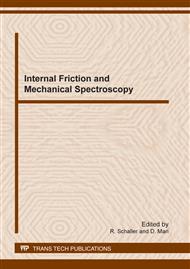[1]
C. Zener, Elasticity and Anelasticity of Metals, University of Chicago Press, Chicago, (1948).
Google Scholar
[2]
A. Puskar, Internal Friction of Materials, Cambridge International Science Publishing, Cambridge, (2001).
Google Scholar
[3]
V. Buscaglia, C. Bottino, R. Musenich, P. Fabricatore, G. Gemme, R. Parodi, B. Zhang, P. Parodi, Nitridation of niobium-46 wt. % titanium alloy in nitrogen at 1300 °C, J. Alloys Comp. 226 (1995) 232.
DOI: 10.1016/0925-8388(95)01614-7
Google Scholar
[4]
J.L. Snoek, Effect of Small Quantities of Carbon and Nitrogen on the Elastic and Plastic Properties of Iron, Physica 8 (1941) 711.
DOI: 10.1016/s0031-8914(41)90517-7
Google Scholar
[5]
A.S. Nowick, B.S. Berry, Anelastic Relaxation in Crystalline Solids, Academic Press, New York, (1972).
Google Scholar
[6]
M. Weller, G.Y. Li, J.X. Zhang, T.S. Kê, J. Diehl, Accurate Determination of Activation Enthalpies Associated with the Stress-Induced Migration of Oxygen or Nitrogen in Tantalum and Niobium, Acta Metall. 29 (1981) 1047.
DOI: 10.1016/0001-6160(81)90056-0
Google Scholar
[7]
M.S. Ahmad, Z.C. Szkopiak, Snoek Relaxation Peaks in Solid Solutions of Niobium, J. Phys. Chem. Sol. 31 (1970) 1799.
DOI: 10.1016/0022-3697(70)90170-8
Google Scholar
[8]
M. Weller, J.X. Zhang, G.Y. Li, T.S. Kê, J. Diehl, Internal Friction Study on the Existence of Oxygen Pairs in Interstitial Solid Solution of Tantalum with Oxygen Acta Metall. 29 (1981) 1055.
DOI: 10.1016/0001-6160(81)90057-2
Google Scholar
[9]
M. Weller, G. Haneczok, J. Diehl, Internal Friction Studies on Oxygen–Oxygen Interaction in Niobium. I. Experimental Results and Application of Previous Interpretations, Phys. Stat. Sol. (b) 172 (1992) 145.
DOI: 10.1002/pssb.2221720115
Google Scholar
[10]
C.R. Grandini, A Low Cost Automatic System for Anelastic Relaxations Measurements, Rev. Bras. Apl. Vácuo 21 (2002) 13.
Google Scholar
[11]
J.D. Fast, Gases in Metals, Philips Tech. Library, London, (1976).
Google Scholar
[12]
M. Weller, Anelastic Relaxation of Interstitial Foreign Atoms and their Complexes with Intrinsic Defects in B.C.C. Metals, J. de Physique 46 (1985) C10-7.
DOI: 10.1051/jphyscol:19851002
Google Scholar
[13]
O. Florêncio, W.J. Botta Filho, C.R. Grandini, H. Tejima, J.A.R. Jordão, Anelastic Behaviour in Nb-Ti Alloys Containing Interstitial Elements, J. Alloys Comp. 211 (1994) 37.
DOI: 10.1016/0925-8388(94)90442-1
Google Scholar
[14]
C.R. Grandini, L.E.C. Ferreira, H.R.Z. Sandim, O. Florêncio, H. Tejima, J.A.R. Jordão, Internal Friction Measurements in Nb-0. 3wt%Ti Containing Oxygen, J. de Physique IV 6 (1996) C8–C135.
DOI: 10.1051/jp4:1996827
Google Scholar
[15]
M.S. Blanter; I.S. Golovin; H. Neuhäuser, H. -R. Sinning, Internal Friction in Metallic Materials, Springer-Verlag, Berlin, (2007).
DOI: 10.1007/978-3-540-68758-0
Google Scholar


